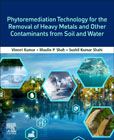
Phytoremediation Technology for the Removal of Heavy Metals and Other Contaminants from Soil and Water
Kumar, Vineet
Shah, Maulin P.
Shahi, Sushil Kumar
Phytoremediation Technology for the Removal of Heavy Metals and Other Contaminants from Soil and Water focuses on the exploitation of plants and their associated microbes as a tool to degrade/detoxify/stabilize toxic and hazardous contaminants and restore the contaminated site. The book introduces various phytoremediation technologies using an array of plants and their associated microbes for environmental cleanup and sustainable development. The book mainly focuses on the remediation of toxic and hazardous environmental contaminants, their phytoremediation mechanisms and strategies, advances and challenges in the current scenario. This book is intended to appeal to students, researchers, scientists and a wide range of professionals responsible for regulating, monitoring and designing industrial waste facilities. Engineering consultants, industrial waste managers and purchasing department managers, government regulators, and graduate students will also find this book invaluable. Provides natural and eco-friendly solutions to deal with the problem of pollution Details underlying mechanisms of phytoremediation of organic and inorganic contaminants with enzymatic roles Describes numerous, successful field studies on the application of phytoremediation for eco-restoration of contaminated sites Presents recent advances and challenges in phytoremediation research and applications for sustainable development Provides authoritative contributions on the diverse aspects of phytoremediation by world leading experts INDICE: 1. Phytoremediation and Environmental Bioremediation2. Phytoremediation: The ultimate technique for reinstating soil contaminated with heavy 3. Phytoremediation: a sustainable green approach for environmental cleanup4. Recent developments in Aquatic Macrophytes For Environmental Pollution Control: A case study on heavy metal removal from lake water and agricultural return wastewater with the use of Duckweed (Lemnacea)5. Weed Plants : A boon for remediation of heavy metal contaminated soil 6. Oxidoreductase metalloenzymes as a green catalyst for phytoremediation7. Phytoextraction of heavy metals: Challenges and opportunities 8. Potential and prospects of weed plants in phytoremediation and eco-restoration of heavy metals polluted sites9. Biochemical and Molecular Aspects of Heavy Metal Stress Tolerance in Plants10. Monitoring the Process of Phytoremediation of Heavy Metals Using Spectral Reflectance and Remote Sensing11. Phytostabilization of metal Mine Tailings - A green Remediation Technology12. Phytoremediation of Heavy Metals, Metalloids and Radionuclides: Prospects and Challenges13. Phytoremediation of Metals: Lithium14. Aquatic Macrophytes for Environmental Pollution Control15. Role of rhizobacteria from plant growth promoter to bio-remediator16. Role of Nanomaterials in Phytoremediation of Tainted Soil17. Green technology: Phytoremediation for pesticide pollution18. Phytoremediation of Persistent Organic Pollutants: Concept, challenges, and perspectives19. Gene Mediated Phytodetoxification of Environmental Pollutants20. Nano-phytoremediation technology in Environmental Remediation21. Nano-phytoremediation technology: A better approach for Environmental Remediation of toxic materials22. Constructed wetlands plant treatment system: An eco-sustainable phytotechnology for treatment and recycling of hazardous wastewater23. Ecological Aspects of Aquatic Macrophytes for Environmental Pollution Control: An Eco-Remedial Approach24. Phytoremediation of Trace Elements from Paper Mill Wastewater with Pistia stratiotes L.: Metal Accumulation and Antioxidant Response 25. Electrokinetic-Assisted Phytoremediation of Heavy Metal Contaminated Soil: Present Status, Challenges and Opportunities26. Microbes Assisted Phytoremediation of Contaminated Environment: Global Status, Progress, Challenges and Future Prospects27. Electricity Production And The Analysis Of The Anode Microbial Community In A Constructed Wetland Microbial Fuel Cell28. Phytocapping Technology for Sustainable Management of Contaminated Sites: Case Studies, Challenges and Future Prospects
- ISBN: 978-0-323-85763-5
- Editorial: Elsevier
- Encuadernacion: Rústica
- Páginas: 664
- Fecha Publicación: 10/02/2022
- Nº Volúmenes: 1
- Idioma: Inglés
